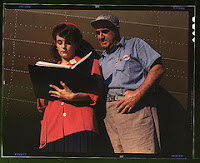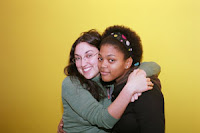 GUEST BLOGGER: Jacqueline Hudak, M.Ed., Ph.D. is a feminist family therapist who has been working with individuals, couples and families for over twenty years. On a more personal note, Jacqueline is the mother of Lauren, 16, and Vincent, 12 and together with her partner Sarah, they live in Atlantic Highlands NJ. When not thinking about relationships, Jacqueline is a devoted student of yoga, which, as she has said, teaches her to go forward with an open heart, and see the world in different ways. She’s a popular teacher, speaker, and family therapy supervisor, and has lectured widely on a variety of topics that impact family life. Jacqueline is an Adjunct Faculty at Drexel University’s Programs in Couple and Family Therapy and is currently at work on two books: a memoir, and a compilation of stories from her years in practice. She is also a “graduate” of my Making It Pop: Translating Your Ideas for Trade seminar, and I’m SO EXCITED to read her books, and to share this guest post from her here! Here’s Jacqueline. -GWP
GUEST BLOGGER: Jacqueline Hudak, M.Ed., Ph.D. is a feminist family therapist who has been working with individuals, couples and families for over twenty years. On a more personal note, Jacqueline is the mother of Lauren, 16, and Vincent, 12 and together with her partner Sarah, they live in Atlantic Highlands NJ. When not thinking about relationships, Jacqueline is a devoted student of yoga, which, as she has said, teaches her to go forward with an open heart, and see the world in different ways. She’s a popular teacher, speaker, and family therapy supervisor, and has lectured widely on a variety of topics that impact family life. Jacqueline is an Adjunct Faculty at Drexel University’s Programs in Couple and Family Therapy and is currently at work on two books: a memoir, and a compilation of stories from her years in practice. She is also a “graduate” of my Making It Pop: Translating Your Ideas for Trade seminar, and I’m SO EXCITED to read her books, and to share this guest post from her here! Here’s Jacqueline. -GWP
Intimate Justice at Bluestockings NYC!
Intimate justice – doesn’t the sound of it just make you want some?
It was a beautiful scene on the evening of February 13th: a venerable old feminist bookstore, chock full of folks to celebrate the publication of Making Love Playing Power: Men, Women and the Rewards of Intimate Justice by my pal, Ken Dolan-DelVecchio. What an amazing book!
I was admittedly thrilled, but nervous, when upon our arrival at Bluestockings Ken asked me to introduce him. Given my heartfelt respect for this man and the work that we share, I of course, said ‘yes.’ I knew I could find the words, because in my mind, well, perhaps mostly in my heart, I knew how ready we are for a book like this, and how urgently it is needed.
This is because those of us who transgress the lines between doing ‘therapy’ and social justice work try to open our clients and families to new ways of seeing their lives. In my clinical work, I pursue the questions that might help someone see possibility where previously there was none. In this book, Ken provides a clear map of how gender, race, class and sexual orientation influence power in a relationship – and how the imbalance of power is at the root of most conflict. This dynamic is generally not talked about – even by supposed ‘experts’. Ken helps focus our understandings of how we are taught to be male or female, and what cost that exacts from relationships with those we love. This book enacts the revolutionary ideas that men are fully capable of deep intimacy and connection, and women, of empowerment and self-love.
With so many self help books on the market, it is so refreshing to find one that has a chapter entitled “What Patriarchy Teaches Men.†AND it is written by a man. I can only begin to imagine the ways in which sharing this book will enhance my clinical work with couples and families. The dominant psychology of our culture teaches us to look inside the person or relationship for “the problem.†Yet “the problem†is so often outside of the relationship – and the tricky thing is, we don’t talk about it. As a culture, we don’t acknowledge the ways in which the presence or absence of racism, poverty, gender privilege, or heterosexism (to name a few) shape and give meaning to our lives. Instead, we couch the struggles in pseudo-diagnostic terms: “communication problemsâ€, “anger management,†“codependency.†We thus never get to talk about or take action against the structures that support these hierarchies of privilege and oppression within which all families live.
As the mother of an almost teenage boy, I am also deeply concerned about the ways in which he is taught by our culture to be a man. Can he stay the big-hearted, emotional and tender person I have known for 12 years? Must he become indoctrinated into the traditional world of masculinity? I know all of the rhetoric about how men have changed, but has the culture of masculinity? (that’s a whole other blog!) I see the extreme self reliance, the inability to ask for help or be viewed as dependent, in many “younger†men in my practice. I know Ken shares that concern for his son and share that in his dedication: “For your generation, may you know love more than domination and truth more than fear.â€
Making Love Playing Power: Men, Women and the Rewards of Intimate Justice is the relationship guide we have been waiting for. Thank you, Ken, for opening so many possibilities to couples and families. Your clarity, dedication and tenderness shine through!
You can reach Jacqueline at jack4fta@comcast.net.
 As folks who know me know, I’m endlessly fascinated with the intergenerational divide among women going on around this election. And I’ve come to feel like those my age occupy an odd place here on the cusp of 40. Many of the polls show the cut-off for Hillary vs. Obama support among women voters as being age 40. We all know that cut-off numbers are often random but convenient divisors, false but convenient truths. Still, I can’t help but wonder, does my earlier waffling reflect some kind of generational fence-sitting?
As folks who know me know, I’m endlessly fascinated with the intergenerational divide among women going on around this election. And I’ve come to feel like those my age occupy an odd place here on the cusp of 40. Many of the polls show the cut-off for Hillary vs. Obama support among women voters as being age 40. We all know that cut-off numbers are often random but convenient divisors, false but convenient truths. Still, I can’t help but wonder, does my earlier waffling reflect some kind of generational fence-sitting?







